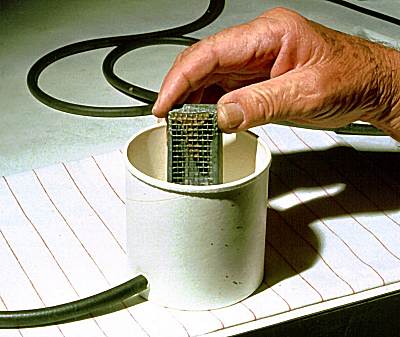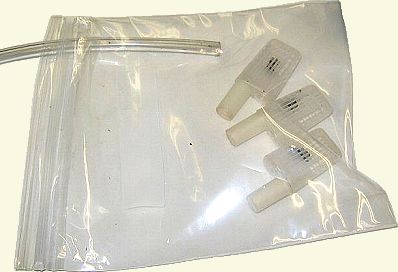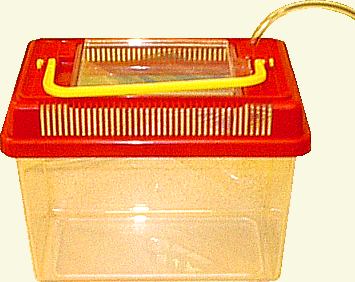
CO2 is heavier than air and so it can be used to flood an open topped vessel.
The picture at right comes from the Dadant slide set and shows a queen in an ordinary travelling cage being hand dunked into a plastic beaker that is fed CO2 at a slow constant rate via a rubber tube. Once the container is full of CO2 then the same rate of flow as is used for the actual insemination can be used to make up the losses, that are due to minor air currents. The ambient conditions need to be still air, but adequate ventilation is required at floor level to avoid any build up of CO2 in the room.
If several queens are to be dosed at the same time, you can use a zip lock freezer bag to contain the CO2, the photo below that shows this method, is from Tim Arheit.
For dosing several queens at the same time, Ron Hoskins has found an ideal vessel known as a guppy trap... It is a plastic box with a ventilated lid, that is intended for the breeding of guppies in an aquarium. Various types of fish breeding traps are available, but only those that have a non vented box, with the ventilation in the lid portion are suitable. The plastic tube in Ron's version is a push fit in a hole drilled in the lid.


Dosing time is not critical, five to ten minutes is adequate. It is thought that the rise of CO2 in the haemolymph that results from such dosing, mimics the rise in CO2 that would occur on mating flights, due to exercise of the flight muscles. We know that drones are not fully mature until they have done adequate flying and the Jackman drone flight proving method will establish that a drone has flown at least once, I conjecture that CO2 produced in flight muscles may be a part of this process. So some investigation needs to take place to establish whether deliberate CO2 dosing would be helpful in producing mature drones.
Dosing the day before insemination would seem to offer a better solution than dosing the day after, but this is only because disturbance after insemination and re-introduction of the inseminated queens is reduced. from the point of view of bringing the queens into lay, I do not think that there is much difference between the extra dose being the day before or the day after.
The dose of CO2 that a queen receives during the actual insemination process, is dependent on time taken as the delivery rate is constant during the procedure. So the dose will vary in inverse ratio to the ability of the inseminator. This is not a big deal as the first few attempts of anyone learning II are going to take longer, but the queens concerned may well be sacrificed as part of the quality control process, in order to establish that the insemination was successful.
Timing and Speed...Once the practice session has been assimilated into routine, the speed of insemination goes up and becomes reasonably consistent from queen to queen. The time for inseminating each queen, including semen harvesting, and marking with a numbered disc along with making up the record register amounts to about 15 minutes after sufficient skill is acquired.